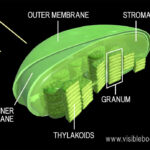Fighting in Ukraine continues after Russia initiated a full-scale invasion three years ago. While Ukrainian forces have demonstrated resilience and launched counter-offensives, Russia has gradually expanded its territorial control, particularly in eastern Ukraine. This analysis provides a geographical overview of the conflict, highlighting key areas and shifts in control.
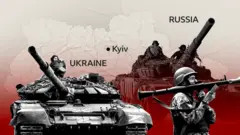 Troops on tanks with a map of Ukraine and Russia, illustrating the ongoing conflict between the two nations
Troops on tanks with a map of Ukraine and Russia, illustrating the ongoing conflict between the two nations
Despite diplomatic discussions and statements regarding potential peace negotiations, the situation on the ground remains dynamic. Recent reports indicate Russia’s continued advances in the east, while Ukraine explores strategic options, including potential territorial adjustments.
Russia’s Eastern Push: Grinding Forward in the Donbas
The eastern regions of Ukraine have become the primary focus of Russia’s military operations. Employing a strategy of attrition, Russian forces have made incremental gains in the Donbas, advancing through open terrain and overcoming Ukrainian defenses in villages and towns.
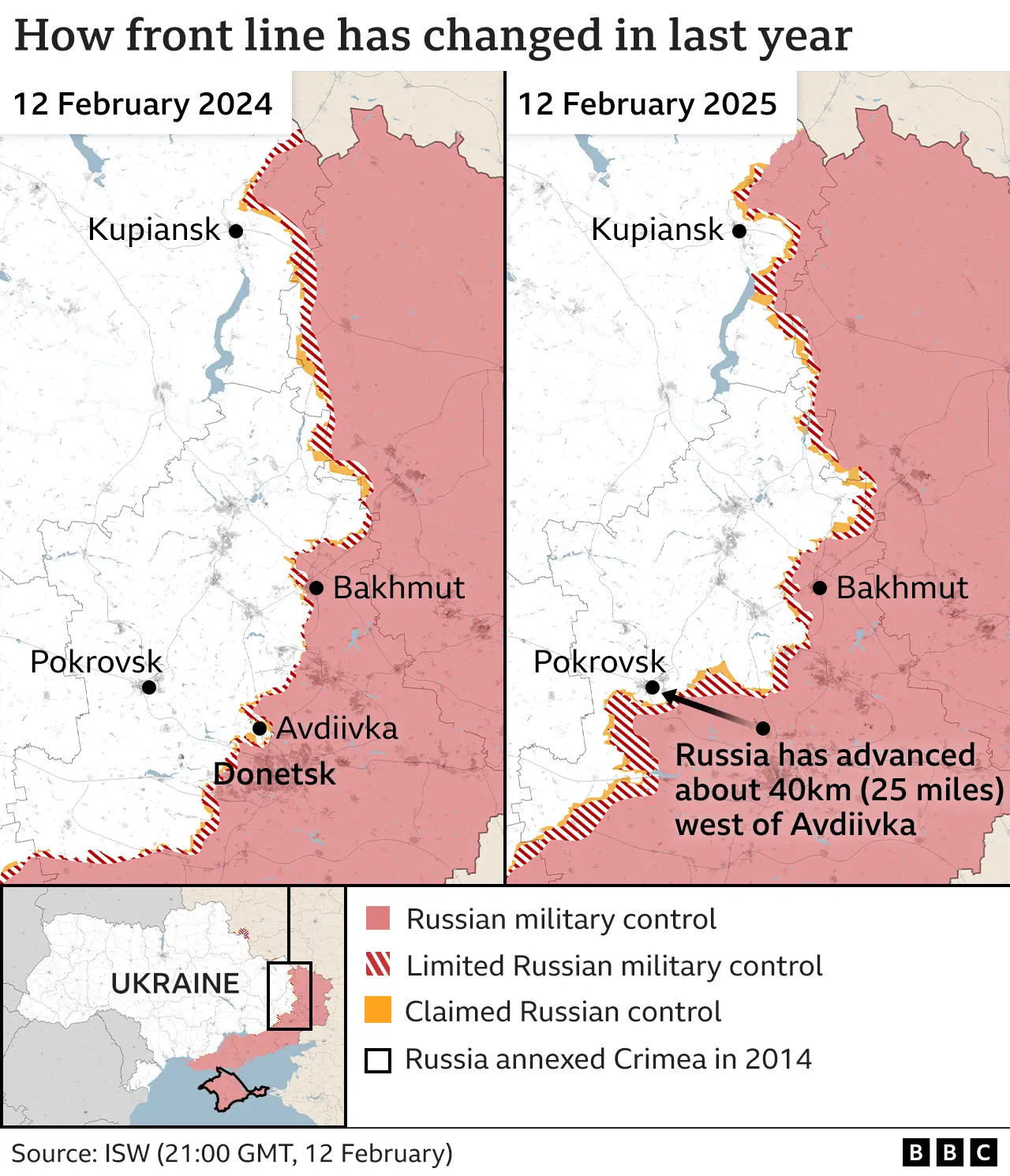 Maps showing the change in Russian controlled areas in eastern Ukraine between February 2024 and February 2025, highlighting Russian territorial gains west of Avdiivka
Maps showing the change in Russian controlled areas in eastern Ukraine between February 2024 and February 2025, highlighting Russian territorial gains west of Avdiivka
Russia’s numerical advantage in manpower has been a significant factor, enabling them to sustain offensives despite losses. Experts anticipated this eastern focus, with Russian forces concentrating on seizing key frontline locations. Notably, Kurakhove has fallen under Russian control, and advances continue towards Pokrovsk.
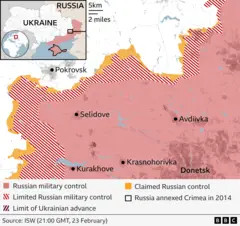 Detailed map of western Donetsk region showing areas under Russian military control, emphasizing the Russian advance towards Pokrovsk
Detailed map of western Donetsk region showing areas under Russian military control, emphasizing the Russian advance towards Pokrovsk
The advance towards Pokrovsk represents the most substantial shift in the Donetsk front in recent months. However, Ukrainian forces are employing innovative tactics, integrating drones and ground troops, to inflict casualties and impede Russian progress, slowing the offensive significantly. It has taken Russian forces a year to advance approximately 40km westward, facing fierce resistance and ultimately capturing Avdiivka in February 2024 after prolonged and intense combat. Avdiivka, once home to over 30,000 residents, is now largely deserted and devastated.
Northern Front and Kharkiv: An Incursion from Belgorod
In addition to the eastern front, Russia initiated a northern operation in May 2024, crossing the international border into the Kharkiv region. This move, considered a “subordinate main effort,” involved seizing several villages north of Kharkiv, Ukraine’s second-largest city, leading to civilian displacement.
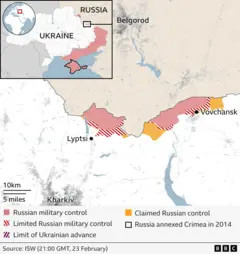 Map illustrating the Russian incursion north of Kharkiv from the Belgorod region, showing consolidated Russian territory gains
Map illustrating the Russian incursion north of Kharkiv from the Belgorod region, showing consolidated Russian territory gains
This northern push occurred during a period when US weapon supplies to Ukraine were interrupted. Despite initial advances, Ukrainian forces stabilized the front. While Kharkiv has endured glide bomb attacks from Russian aircraft, it remains beyond the reach of Russian artillery, highlighting the limits of Russia’s northern gains.
Territory Discussions and Shifting Borders: Proposals and Counter-Offensives
Eastern Ukraine has been a contested area since 2014, with Russian-backed separatists seizing parts of Donetsk and Luhansk. Russia’s annexation of Crimea also occurred in 2014, establishing a long-term Russian presence in Ukrainian territory.
Amid ongoing conflict, discussions about potential territorial swaps have emerged. Ukrainian President Volodymyr Zelensky suggested the possibility of exchanging Russian-held Ukrainian territory for territory gained by Ukraine in Russia’s Kursk region. This proposal reflects the complex and fluid nature of territorial control in the conflict.
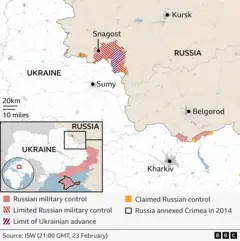 Map showing Ukrainian counter-offensives into Russia's Kursk region and areas regained by Russia, illustrating shifting territorial claims
Map showing Ukrainian counter-offensives into Russia's Kursk region and areas regained by Russia, illustrating shifting territorial claims
Ukraine launched a cross-border attack into the Kursk region in August, advancing significantly and prompting evacuations. While Russia has regained some territory, Ukrainian forces maintain a presence in Kursk, demonstrating Ukraine’s capacity to project force beyond its borders. However, Russia has dismissed any suggestion of a territory swap as “impossible,” underscoring the deep divisions and lack of consensus on territorial issues.
Three Years of War: Key Geographical Shifts
Russia’s full-scale invasion commenced in February 2022 with widespread missile strikes across Ukraine, marking a dramatic escalation of the conflict. Initial Russian advances were rapid, reaching the outskirts of Kyiv and seizing territory in the east and south, including Kherson and Mariupol.
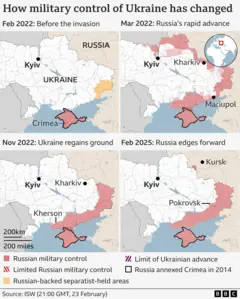 Four maps depicting the territorial control changes in Ukraine since the Russian invasion, showing initial Russian advances and subsequent Ukrainian counter-offensives
Four maps depicting the territorial control changes in Ukraine since the Russian invasion, showing initial Russian advances and subsequent Ukrainian counter-offensives
However, Russian forces encountered strong Ukrainian resistance and logistical challenges. Ukrainian forces effectively utilized Western-supplied weaponry, such as NLAW anti-tank systems, to halt the Russian advance. By October 2022, Ukraine had successfully defended Kyiv, leading to a complete Russian withdrawal from northern Ukraine. Subsequently, in November 2022, Ukrainian forces liberated Kherson.
Since these major shifts, the conflict has largely concentrated in eastern Ukraine, characterized by slow, grinding Russian advances. Casualty estimates are substantial, with significant losses on both sides. The geographical dynamics of the conflict continue to evolve, reflecting the ongoing struggle for territorial control and influence.
By Dominic Bailey, Mike Hills, Paul Sargeant, Chris Clayton, Kady Wardell, Camilla Costa, Mark Bryson, Sana Dionysiou, Gerry Fletcher, Kate Gaynor and Erwan Rivault
About these maps: Territorial control assessments are based on daily reports from the Institute for the Study of War and the American Enterprise Institute’s Critical Threats Project. The situation is fluid, and maps may not always reflect the very latest changes.
War in Ukraine
Volodymyr Zelensky
Russia
Vladimir Putin
Ukraine


